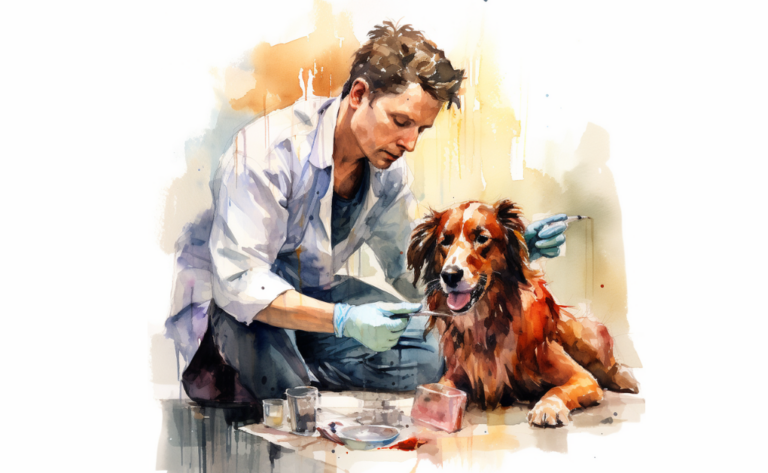Exploring Degenerative Mitral Valve Disease in Dogs
What is it?
How is it Treated?
Breed Predispositions
Cavalier King Charles Spaniel Dachshund Miniature Schnauzer Poodle Chihuahua Boston Terrier Fox Terrier Jack Russell Terrier Yorkshire Terrier Shih Tzu
Introduction
Every evening, Emma cherished her daily walks with Charlie, her devoted Cavalier King Charles Spaniel. Over time, however, she noticed that Charlie was becoming increasingly fatigued and short of breath during their outings. Worried about her beloved companion, Emma took him to the veterinarian for a thorough examination. After careful evaluation, the vet diagnosed Charlie with degenerative mitral valve disease, a progressive heart condition that affects many dogs.
Degenerative Mitral Valve Disease in dogs, often referred to as mitral insufficiency or myxomatous mitral valve disease, is a cardiac condition where the mitral valve, situated between the left atrium and left ventricle of the heart, becomes impaired or dysfunctional. This malfunction can lead to leakage, causing blood to reverse flow into the left atrium rather than proceed into the left ventricle and subsequently to the rest of the body.
Consequently, the heart must exert more effort to pump blood effectively, which could eventually precipitate heart enlargement – a condition linked to reduced cardiac function and, potentially, congestive heart failure accompanied by pulmonary edema. It’s estimated that roughly 10 percent of dogs may experience some form of heart disease during their lifetimes, and most of these cases are caused by myxomatous mitral valve degeneration. This condition is prevalent in older dogs and is frequently seen in small-breed dogs.
What is Mitral Valve?
The mitral valve is a vital component of a dog’s heart, located between the left atrium and left ventricle. It is a one-way valve responsible for regulating the flow of oxygen-rich blood within the heart. When the left atrium contracts, the mitral valve opens, allowing blood to flow from the left atrium to the left ventricle. As the left ventricle contracts to pump the blood out to the rest of the body, the mitral valve closes to prevent blood from flowing back into the left atrium.
A healthy mitral valve ensures efficient blood circulation and maintains proper heart function in dogs. When the mitral valve becomes damaged or doesn’t function correctly, it can lead to mitral valve disease, which affects the heart’s ability to pump blood effectively and may result in various health problems for the dog.
Classifications of MVD in Dogs
Congenital and acquired mitral valve diseases are classifications of mitral valve disorders in dogs based on their origin.
Congenital Mitral Valve Disease
This type of mitral valve disease is present at birth, meaning the dog is born with the abnormality. It occurs due to improper development of the mitral valve during the dog’s fetal development. One common form of congenital mitral valve disease is mitral valve dysplasia, where the valve does not form correctly, leading to a leaky valve, a narrowed opening (stenosis), or both. Some breeds, such as Bull Terriers, German Shepherds, and Golden Retrievers, may be more predisposed to congenital mitral valve disease.
Acquired Mitral Valve Disease
Acquired mitral valve disease develops over time, usually due to age-related degeneration or other factors such as infections or injury. The most common form of acquired mitral valve disease is Degenerative Mitral Valve Disease (DMVD), also known as chronic valvular disease or endocardiosis. In DMVD, the valve leaflets (cusps) thicken and become less flexible, causing the valve to leak and allowing blood to flow back into the left atrium. This type of mitral valve disease is more common in small breed dogs, such as Cavalier King Charles Spaniels, Poodles, and Dachshunds.
Both congenital and acquired mitral valve diseases can lead to similar symptoms and complications, including heart enlargement, reduced cardiac function, and congestive heart failure. However, the severity and progression of the disease can vary depending on the underlying cause, the dog’s breed, and other individual factors.
Causes of Mitral Valve Disease in Dogs
The causes of Degenerative Mitral Valve Disease (DMVD) in dogs, often linked to mitral valve degeneration and atrial enlargement, can be divided into two primary categories: congenital and acquired. Understanding these causes can aid dog owners and veterinarians pinpoint risk factors and implementing preventive measures for the dog’s overall health and heart size management.
Congenital Causes
This form of DMVD originates from birth, attributed to anomalies in the mitral valve’s development during the fetal stage. In addition, genetic influences and hereditary tendencies play a role in congenital mitral valve disease. Certain breeds, including Bull Terriers, German Shepherds, and Golden Retrievers, are likelier to be born with abnormal valve structures, including the mitral valve leaflet.
Acquired Causes
Acquired mitral valve disease, including cases of mitral valve stenosis, evolves due to a variety of reasons:
- Degenerative changes: As a progressive disease, age-related deterioration can cause the mitral valve to degenerate, resulting in a thickened and less flexible valve leaflet. This degeneration is the predominant cause of DMVD, also referred to as chronic valvular disease or endocardiosis.
- Infections: Infectious agents like bacteria can lead to infective endocarditis, impacting the heart valves, including the mitral valve. Such infections can impair valve structure and functionality, leading to mitral valve disease.
- Injury: Chest or heart trauma can harm the mitral valve, resulting in valve dysfunction.
- Systemic diseases: Certain systemic conditions, including autoimmune disorders and cancer, can prompt inflammation or damage to the mitral valve, contributing to the development of mitral valve disease.
It’s crucial to note that some dog breeds, specifically small breeds such as Cavalier King Charles Spaniels, Poodles, and Dachshunds, have a heightened susceptibility to acquired mitral valve disease, particularly DMVD. Consequently, these breeds are more prone to cardiovascular disease and conditions like congestive heart failure in dogs.
Symptoms of Mitral Valve Disease in Dogs
Degenerative Mitral Valve Disease (MVD) in dogs manifests through a spectrum of clinical signs, with the severity and progression of the condition determining the observed symptoms. These symptoms can be segmented into mild, intermittent, and severe stages:
Mild MVD Symptoms
During the initial stages of MVD, many dogs may exhibit little to no discernable symptoms. Nonetheless, some dogs might present with sporadic coughing, especially post-exercise or nocturnally, possibly marking the first sign of the disease. Other mild symptoms could encompass a minor decline in activity levels or a barely noticeable alteration in breathing patterns. Dogs with heart murmurs may also start to show these symptoms.

Intermittent MVD Symptoms
As MVD advances, symptoms become more perceptible and may occur intermittently.
Dogs might show dyspnea, shortness of breath, rapid breathing, and increased coughing frequency. It may also experience fatigue or weakness, particularly during physical exertion, indicating signs of heart failure. Potential signs include weight loss. Reduced appetite and a decline in overall energy levels.
Severe MVD Symptoms
During the advanced stages of mitral valve disease, dogs present more critical symptoms due to the onset of congestive heart failure. They may experience:
- Labored breathing, potentially indicative of pulmonary hypertension.
- Frequent episodes of fainting or collapsing (syncope).
- Cyanosis, characterized by bluish or pale gums resulting from inadequate oxygen levels.
- A swollen abdomen due to fluid accumulation (ascites).
- A weak or rapid pulse.
These severe symptoms, often signs of congestive heart failure, necessitate immediate veterinary intervention and can be life-threatening if unaddressed.
Diagnosis of Mitral Valve Disease in Dogs
Diagnosing Degenerative Mitral Valve Disease (MVD) in dogs requires a detailed examination and a range of diagnostic tests to ascertain the severity of the condition and devise a suitable treatment plan. In the field of veterinary medicine, these tests are frequently employed to diagnose MVD in dogs:
Physical Examination
A veterinarian initiates the diagnostic process with an in-depth physical examination. Subsequently, the vet employs a stethoscope to listen to the dog’s heart to identify any heart murmurs or unusual sounds potentially indicative of MVD or mitral valve regurgitation.
Chest X-ray
Chest X-rays play a vital role in diagnosing MVD, enabling the vet to visualize the dog’s heart and lungs. An enlarged heart, particularly on the left side of the heart, including the left atrium and ventricle, may suggest MVD. Additionally, the vet may check for signs of fluid accumulation in the lungs, a common symptom of congestive heart failure resulting from MVD.
Electrocardiogram (ECG)
The electrocardiogram (ECG), a non-invasive procedure, tracks the electrical activity of the dog’s heart. This test can help identify irregular heartbeats (arrhythmias) and offer valuable insights into the disease progression and the severity of the condition.
Echocardiogram
The echocardiogram, a cardiac ultrasound, is an indispensable diagnostic tool for MVD. It employs sound waves to generate a comprehensive, real-time image of the dog’s heart, allowing the vet to evaluate the structure and function of the mitral valve, cardiac output, and blood flow. It can also help estimate the valve leakage’s severity and assess the heart muscle’s overall function.
Blood and Urine Tests
Blood and urine tests provide information about the dog’s overall health status and help identify any coexisting medical conditions. Blood tests may include a complete blood count (CBC) and a blood chemistry panel, while a urinalysis can disclose signs of potential kidney function problems, which may be linked to MVD.
By combining these diagnostic tests with a thorough medical history and physical examination, veterinarians can effectively determine the severity of MVD and devise a suitable treatment plan for the affected dog. For dogs in the preclinical phase of myxomatous mitral valve disease, these tests can be crucial for early diagnosis and treatment. Also, veterinarians might consider using drugs like ACE inhibitors to manage the condition.
Treatment for Degenerative Mitral Valve Disease in Dogs
Addressing Degenerative Mitral Valve Disease (MVD) in dogs entails employing various strategies depending on the severity of the condition, the age of the dog, and any existing health issues. The primary aim of treatment is to alleviate symptoms, retard the progression of mitral valve disease, and enhance the dog’s quality of life. Below are some standard treatment approaches for MVD in dogs:
Medical Management
Mild to moderate instances of MVD are typically initially treated with medical management, which can include administering various medications such as:
- Diuretics to eliminate surplus fluid from the body, thereby reducing the pressure on the dog’s heart
- ACE inhibitors to facilitate blood vessel relaxation, decrease blood pressure, and diminish the heart’s workload
- Positive inotropes to bolster heart contractions and elevate cardiac output
- Beta-blockers to decelerate the heart rate and reduce the strain on the heart
- Calcium channel blockers to assist in regulating heart function and controlling arrhythmias

Surgical Intervention
Surgical intervention might sometimes be necessary to address the underlying problems and enhance the dog’s heart function. Although surgery can be a successful treatment option for some dogs with MVD, it may only be suitable for some, particularly those with severe heart failure or other significant health concerns.
A professional in internal medicine or a veterinary cardiologist will assess the dog’s overall health, the severity of mitral regurgitation, and the potential risks and benefits of surgery to ascertain the most appropriate treatment plan for each case. Here are two primary surgical options for dogs with MVD:
- Mitral Valve Repair: Occasionally, the mitral valve can be repaired by stitching the valve leaflets or adjusting the chordae tendineae (the fibrous cords connecting the valve leaflets to the heart muscle). This surgery aims to enhance the valve’s function, reduce regurgitation, and alleviate the symptoms associated with MVD. However, mitral valve repair is technically demanding, and not all veterinary surgeons have the requisite experience to perform this surgery.
- Mitral Valve Replacement: This procedure entails removing and replacing the damaged mitral valve with a prosthetic valve. While mitral valve replacement can be an effective treatment for MVD, it is a highly invasive procedure with a higher risk of complications. Therefore, this surgery is typically reserved for cases where repair is infeasible or unsuccessful. However, the availability of mitral valve replacement for dogs is limited as it requires specialized expertise and equipment.
Weight Management and Diet
Maintaining a healthy weight and a balanced diet is crucial for dogs with MVD, as excess weight can place additional strain on the heart. A veterinarian may recommend a specific diet plan, including low-sodium options, to help manage fluid retention and reduce the workload on the heart.
Exercise and Activity Restriction
It’s essential to consult with your veterinarian before starting any exercise program for your dog with mitral valve disease (MVD). They can provide personalized recommendations based on your dog’s condition and overall health. However, there are some general guidelines for exercising dogs with MVD:
- Low-impact activities: Choose low-impact, low-intensity exercises such as leisurely walks or gentle playtime. Avoid high-intensity activities, long runs, or anything that could cause excessive strain on your dog’s heart.
- Short, frequent sessions: Break up exercise sessions into shorter, more frequent periods rather than engaging in long, strenuous activities. This approach allows your dog to get some physical activity without overexerting themselves.
- Monitor your dog: Keep a close eye on your dog during exercise and look for any signs of fatigue, difficulty breathing, coughing, or weakness. If your dog shows any of these symptoms, stop the activity immediately and consult your veterinarian.
- Gradually increase activity: If your dog has been cleared by their veterinarian for exercise, start slow and gradually increase the duration and intensity of their activity. This approach allows your dog’s body to adapt to the increased physical demands.
Dogs require regular monitoring and follow-up visits with their veterinarian to assess the effectiveness of the treatment plan and adjust it as needed. Early detection of changes in the dog’s condition can help optimize the treatment strategy and improve the prognosis.
Prevention of Mitral Valve Disease in Dogs
Preventing mitral valve disease (MVD) in dogs may not always be possible, particularly when it comes to congenital or genetic factors. However, there are several steps pet owners can take to reduce the risk of MVD and maintain their dog’s overall heart health. Here are some preventive measures to consider:
Regular Veterinary Checkups
Regular veterinary checkups, including annual heart screenings, are crucial for the early detection and management of MVD. This allows for timely diagnosis and initiation of appropriate treatment plans, which can help slow disease progression and improve the dog’s quality of life.
Weight Management and Diet
Maintaining a healthy weight is essential for overall heart health in dogs. Obesity can strain the heart and increase the risk of MVD and other heart conditions. Pet owners should work with their veterinarians to establish a balanced diet that meets the dog’s nutritional needs without contributing to weight gain. Low-sodium diets may also be beneficial for dogs predisposed to heart issues.
Regular Exercise
Regular, moderate exercise is vital for maintaining heart health in dogs. However, it is essential to consult a veterinarian to determine the appropriate activity level for a dog predisposed to MVD or other heart conditions.
Avoid Breeding Dogs with Known MVD Risk
For breeders, it is crucial to avoid breeding dogs with a known history of MVD or a genetic predisposition for the disease. This helps reduce the risk of passing on the condition to future generations.
Dental Care
Good dental hygiene can contribute to overall heart health in dogs. Regular teeth brushing, dental cleanings, and dental checkups can help prevent periodontal disease, which has been linked to heart conditions, including MVD.
Monitor for Early Signs
Pet owners should monitor their dogs for early signs of MVD, such as coughing, shortness of breath, or exercise intolerance. Early detection and intervention can help slow the progression of the disease and improve the dog’s quality of life.
Frequently Asked Questions
Disclaimer: The information provided on this veterinary website is intended for general educational purposes only and should not be considered as a substitute for professional veterinary advice, diagnosis, or treatment. Always consult a licensed veterinarian for any concerns or questions regarding the health and well-being of your pet. This website does not claim to cover every possible situation or provide exhaustive knowledge on the subjects presented. The owners and contributors of this website are not responsible for any harm or loss that may result from the use or misuse of the information provided herein.







